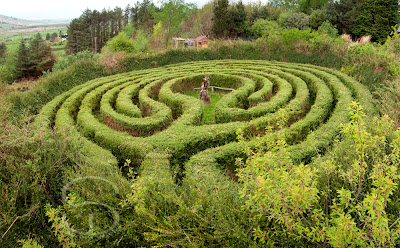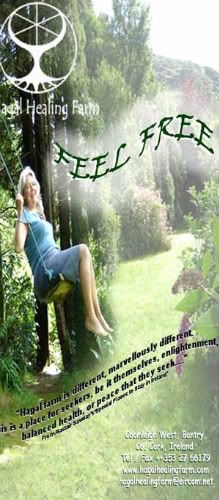Last week I had a mini digger in the garden at Hagal farm. As it was so close by, I thought it would be the perfect opportunity to get a good shot of the labyrinth from high up. So with the arm of the digger high in the air, I propped a ladder up against it, climbed up and got this great shot.
I recently wrote a post over on my Stone Art Blog about the healing effects labyrinths have on Alzheimer's sufferers and thought I might post some of that story here.
More and more hospitals and wellness centres are using labyrinths in the treatment and care of Alzheimer's sufferers. The beauty of a labyrinth (often confused with a maze, which has many paths and dead ends) is that a labyrinth is a single winding path that leads from the entrance to the centre and back out again. All labyrinths are unicursal, meaning they only have one path, which makes them a perfect place for an Alzheimer sufferer to ‘get lost in’. (for more information about labyrinths, check out my previous post about them http://tinyurl.com/gardenlabyrinth)
 |
| The seven circuit classical hedge labyrinth at Hagal Farm |
More and more hospitals and wellness centres are using labyrinths in the treatment and care of Alzheimer's sufferers. The beauty of a labyrinth (often confused with a maze, which has many paths and dead ends) is that a labyrinth is a single winding path that leads from the entrance to the centre and back out again. All labyrinths are unicursal, meaning they only have one path, which makes them a perfect place for an Alzheimer sufferer to ‘get lost in’. (for more information about labyrinths, check out my previous post about them http://tinyurl.com/gardenlabyrinth)
 |
| Labyrinth at Marianjoy Rehabilitation Hospital in Wheaton, Illinois |
While reading up about this subject I came across a very interesting blog by a man called Chuck Donofrio. Chuck’s blog is called ‘Early onset Alzheimer’s Adventure’
Chuck suffers from Alzheimer’s but as he states on his blog ‘Early onset Alzheimer’s diagnosis doesn't stop this "sufferer" from blogging about his day to day observations and feelings.
In one of his posts he writes the following about wanting a labyrinth “One of the most profound meditative experiences available to the lay person, or any other soul desiring a respite from the banality and meaninglessness of our daily round, can be found as near as the closest Labyrinth. The ancient practice of walking the "maze" has captured many a soul, most probably because the physical action of its twists and turns, coinciding with the step and breath of the human in motion, excites, even as it calms.”
Above is a photo Chuck's wife Deb sent me of a labyrinth she made for Chuck last Spring on Sanibel Island. She said 'Every morning we would enjoy the sunrise, then I would meditate on the beach while he walked the labyrinth.'
 |
| Photo sent to me by Deb Donofrio of the Labyrinth she made for Chuck |
The spiritual discipline of the labyrinth involves a "walking meditation" and is a metaphor for the soul's spiritual journey. It quiets the mind and opens the soul to a sense of wholeness and wellness. The tradition of labyrinth walks was recovered in the United States in the early '90s at Grace Cathedral in San Francisco and, in recent years, the labyrinth has come to be recognized as an instrument of holistic healing. The Rev. Canon Lauren Artress of Grace Cathedral has used labyrinth walks with groups of children with ADD/ADHD (attention deficit disorder/attention deficit hyperactive disorder) and has discovered that it helps focus and quiet them in a way that cognitive therapies fail to do.
Since many of the labyrinth projects are still new, they haven't completed any long-term studies. But many places have noticed that this ritual provides benefits such as short-term calming, relaxation, and relief from agitation and anxiety in otherwise fragmented lives. The restorative and calming value of the walk can last from two to three hours, or longer.
I also read of another touching story of a couple that walked, hand in hand, through the labyrinth almost daily. He was suffering from Alzheimer’s, and she was struggling with the confinement, stress, and isolation of being a caregiver. She noticed that after a few weeks of their routine, he began to regain small skills.
Scorces
http://findarticles.com/p/articles/mi_m3830/is_10_50/ai_79355490/pg_2/
http://www.thecabinpath.com/labrynth.html
http://www.medicinenet.com/galantamine/article.htm

















